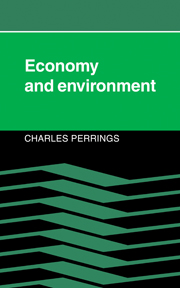 Economy and Environment
Economy and Environment Book contents
- Frontmatter
- Contents
- Preface
- Notation Guide
- 1 Introduction
- Part I The physical economy-environment system
- 2 Closed physical systems: a model
- 3 Structure and time in the physical system
- 4 Technological change and the environmental constraints to physical growth
- Part II The economic system
- Part III Environmental strategies in an evolutionary economy-environment system
- References
- Index
2 - Closed physical systems: a model
Published online by Cambridge University Press: 20 March 2010
- Frontmatter
- Contents
- Preface
- Notation Guide
- 1 Introduction
- Part I The physical economy-environment system
- 2 Closed physical systems: a model
- 3 Structure and time in the physical system
- 4 Technological change and the environmental constraints to physical growth
- Part II The economic system
- Part III Environmental strategies in an evolutionary economy-environment system
- References
- Index
Summary
Elements of the system
A central characteristic of the major models of economic growth – the Neumann, Leontief, and Solow-Samuelson models – is that they are constructed on the basis of a description of the physical conditions of production. The set of production possibilities determines what is argued to be of interest in such models: the equilibrium state of the system and the stability or relative stability of that state. The description of the material transformations of the general economy-environment system discussed below diverges in a number of very fundamental ways from these models, but it rests on the same conviction that the dynamics of economic systems depend on the physical conditions of production. The axiomatic framework of a model of a dynamic economic system should include a stylized description of these conditions. This is what Fuss and McFadden (1978) have called “the traditional starting point of production theory.” It is instructive that they and other proponents of duality theory have since abandoned such an approach on the grounds that economic data allegedly contain all the information relevant to the analysis of production. As we will see, however, the conditions of production remain the only credible basis for the analysis of economic systems unprotected by the free gifts and free disposals assumptions, and managed according to a set of signals as incomplete as the set of prices turns out to be.
- Type
- Chapter
- Information
- Economy and EnvironmentA Theoretical Essay on the Interdependence of Economic and Environmental Systems, pp. 17 - 30Publisher: Cambridge University PressPrint publication year: 1987


